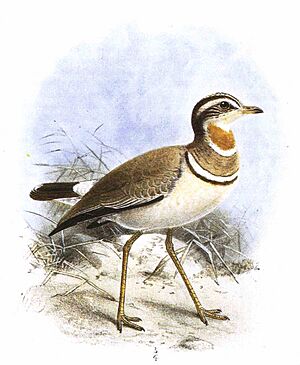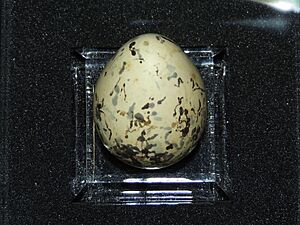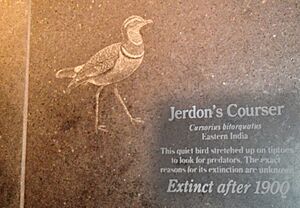Jerdon's courser facts for kids
Quick facts for kids Jerdon's courser |
|
|---|---|
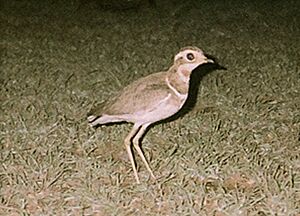 |
|
| Camera trap photograph | |
| Conservation status | |
| Scientific classification | |
| Genus: |
Rhinoptilus
|
| Species: |
bitorquatus
|
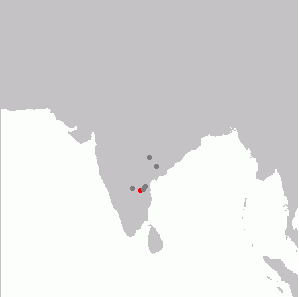 |
|
| Specimen records in grey and current distribution in red. | |
| Synonyms | |
|
Cursorius bitorquatus |
|
The Jerdon's courser (Rhinoptilus bitorquatus) is a special bird that only lives in India. It is active at night, which means it is a nocturnal bird. This bird belongs to the same family as pratincoles and coursers.
A scientist named Thomas C. Jerdon first found this bird in 1848. But after that, no one saw it for a very long time! People thought it might be gone forever. Luckily, it was found again in 1986. Today, it is known to live in the Sri Lankamalleswara Wildlife Sanctuary in Andhra Pradesh. It likes to live in scrub forests with open, bare ground.
Contents
What Does Jerdon's Courser Look Like?
This bird is easy to spot because it has two brown bands across its chest. It has a yellow base on its black bill. Its head is dark, and it has a wide, light-colored stripe above its eye. It also has a bright orange-brown patch on its throat. A thin white stripe runs along the top of its head.
When it flies, you can see its mostly black tail and a clear white stripe on its wing. Jerdon's courser is most active at dawn and dusk. It makes loud, quick calls like Twick-too...Twick-too or yak-wak...yak-wak. These calls repeat about once per second. Sometimes, many birds will call together.
The local people in India call this bird Kalivi kodi. An interesting fact is that the only known egg of a Jerdon's courser is kept in a museum. You can see it at the Zoology Museum, University of Aberdeen.
Where Does Jerdon's Courser Live?
This bird lives only in southern India, mainly in Andhra Pradesh. It has a very small home area. It was found near the Godavari and Pennar rivers. Scientists also found an egg from 1917 that belonged to this bird. This egg helped them learn more about where the bird might have lived.
As we learned, the Jerdon's courser was thought to be extinct for over 80 years. Then, it was rediscovered in 1986. It is mostly active at night. Scientists use special methods to find them. They lay down strips of sand to look for the birds' footprints. This helps them understand where the birds prefer to live. They like areas with tall bushes.
How Jerdon's Courser Was Discovered
The first Jerdon's courser was found by Thomas C. Jerdon in the Eastern Ghats mountains. He gave the bird to a museum in India. Another scientist, Edward Blyth, described the bird and gave it a scientific name.
Later, another scientist named Hugh Edwin Strickland studied a different specimen of the bird. He gave it the name Rhinoptilus bitorquatus, which is its scientific name today. These old specimens are very important for scientists to study.
Protecting Jerdon's Courser
This bird is very rare and is considered critically endangered. This means it is at a very high risk of disappearing forever. It was thought to be extinct until 1986. That's when an ornithologist (a bird scientist) named Bharat Bhushan found it again. He worked with local people to find a bird. Before this, people thought it was a daytime bird, but they learned it is active at night.
The biggest danger to Jerdon's courser is the loss of its home. Its habitat is being changed or destroyed. Scientists believe there are only about 50 to 249 of these birds left. They use camera traps and sand strips to count them. They also try to find new areas where the birds might live. They show pictures and play the bird's calls to people in nearby areas.
In 1988, the Indian Postal Service even released a stamp to celebrate the bird's rediscovery! In 2022, the government gave money to study the bird. This money will help install cameras and sound recorders to track the birds.
Dangers to Jerdon's Courser
The area where the Jerdon's courser lives faces many threats. A large dam project, the Somasilla Dam, caused many villages to move into the bird's habitat. More people living there means more animals grazing and more trees being cut for firewood. Also, quarrying (digging for rocks and minerals) is harming the bird's home. The scrub forests the bird likes are shrinking because of more farming.
In 2005, a project to bring water to the city of Chennai also threatened the bird's home. Legal action helped change the plan for the canal. However, the area is still in danger from illegal building work. There are also plans to connect rivers in India, which could change the habitat even more. All these activities make it harder for the Jerdon's courser to survive.



